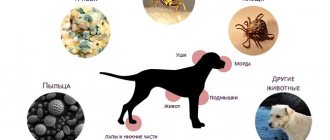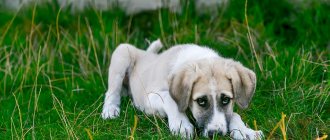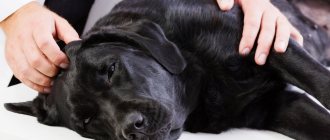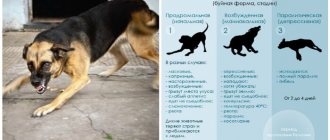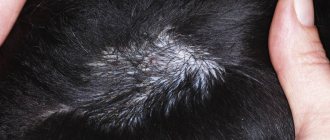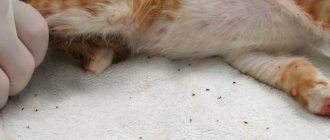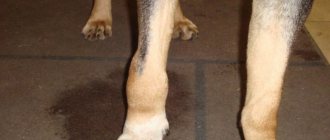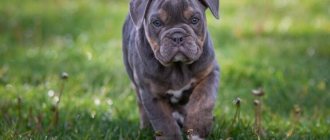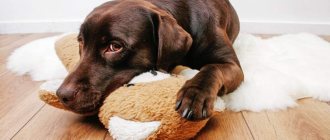Kinds
Most often, the owner can notice the first signs of dandruff when scratching and stroking the pet’s back, as well as the croup area. Manifestations of dandruff can be found behind the ears and on the neck. The appearance of the scales that appear on the skin will help to understand the causes of dandruff and methods of its treatment.
- If dead particles of epithelium easily fall off the fur, then we can safely say that dandruff is dry . This manifestation is accompanied by general dryness of the skin and dehydration. Dull fur is common with this type of dandruff.
- If the pet's fur fat, has an unpleasant odor, is often disheveled, or locally thinned out, then it can be stated skin disease. In this case, dandruff is small yellowish sticky lumps that get stuck on the fur and are difficult to comb out. The dog itches all the time, because skin diseases are accompanied by unbearable itching.
You can also divide dandruff by color:
- White - particles of dead skin. Often, white dandruff appears when hair is falling out or actively falling out.
- Black - so-called pseudo-dandruff. This is not exfoliation of the skin, but of blackheads and clotted blood. Such spots can appear on the skin due to serious disruption of the sebaceous glands and improper combing.
When combing, you can damage the bumps protruding on the surface of the skin, and they “fall off”. This gives the impression that it is black dandruff. This is a sign of hormonal imbalance, which can cause baldness.Common fleas are often confused with black dandruff!
- Yellow - usually a companion to seborrheic dermatitis.
- Red (pink) is not essentially dandruff, but pieces of skin that exfoliate from an infected, inflamed area of the skin due to dermatitis.
REFERENCE: The word “dandruff”, like many medical terms, is of Latin origin, and translated means “bran”
Causes
Why does this problem arise? Dandruff itself does not always clearly indicate a malfunction in the dog’s body. There can be many reasons for its appearance, from a simple change in food or an unsuitable indoor microclimate, to serious damage to the skin by mites. To understand where dandruff comes from, you need to observe your pet.
Why does dandruff appear in dogs?
- Seasonal dandruff on the back during hair loss (molting) is a common phenomenon.
Most dogs live in apartments with central heating, which greatly affects air humidity. As soon as the air becomes drier than usual, shedding begins, which is accompanied by dry dandruff. Usually it goes away when the coat change ends. To alleviate your pet’s condition, you need to comb its fur more often, and also use conditioner when bathing. You can purchase an air humidifier - this will be useful not only for your pet, but also for other inhabitants of the apartment. - If the dog is constantly itching , then dandruff on the coat becomes even more noticeable, especially on the back. There can be many reasons for itching. This is either a food allergy, or a reaction to the bites of blood-sucking insects, or the first manifestations of eczema, seborrhea or other types of dermatitis. Skin parasites can also make themselves felt by unbearable itching.
- Stress . Dogs react differently to the world around them, and some are more susceptible to stressful situations. Stress can be anything - separation from the owner, boredom, fear, and much more. A dog can easily begin to itch due to nervousness, and it is the owner’s duty to protect his friend from nervous shocks.
- Scratching, sores, thickening of the skin in these places, severe oily dandruff, in which a lot of hair climbs and falls out - an unambiguous signal from the dog’s body about a skin disease. This could be atopic dermatitis, allergies, seborrhea, scabies, demodicosis and many other infectious and unpleasant diseases for the dog. If your pet is in this condition, you should never postpone a visit to the veterinarian!
- If the dog behaves as usual , but dandruff is normal for it, then it is worth thinking about how high-quality nutrition the pet receives.
Economy class food, food from the master's table, fatty, salty, sweet - all this should be prohibited. When choosing food, it is best to pay attention to premium food that contains the optimal amount of essential nutrients and vitamins. A good alternative to ready-made food can be preparing your own food for your dog. - A nonspecific cause of dandruff in a dog can be improper hair care, too frequent or, conversely, too infrequent washing, or inappropriate shampoo.
REFERENCE: The PH level of a dog’s skin is 8, while a human’s is 5.5.
Instead of the owner's shampoo and conditioner, when bathing your four-legged friend, you need to use special products intended only for dogs.
Why does my dog have dandruff and hair loss?
The skin is constantly renewed. The cells of its upper layer gradually die off, and their place is replaced by the same ones, only new epidermal cells. This process is physiological and is not noticeable to the owner. But in case of dry or oily skin and excessive exfoliation of the top layer , this becomes a clearly visible problem.
The appearance of dandruff can indicate various errors in maintenance and care or problems with the dog’s health. The main causes of dandruff can be:
Reason #1. Insufficient air humidity in the room where the pet lives. This phenomenon is observed especially often during the cold seasons, when various heaters dry out the air. In addition to problems with the skin and coat, this can cause breathing problems. It is necessary to stock up on air humidifiers to normalize the parameters in the room.
Reason #2. Poor, unbalanced diet. The absence or incorrect proportions of vitamins and various essential elements in a pet’s diet often lead to diseases. Naturally, the condition of the dog’s skin and coat also worsens.
Feeding cheap branded dog food can also lead to this, since they contain many harmful additives, which compensate for the cheap products from which the food is made that are unattractive to animals.
It is also harmful to give ready-made food, even of super-premium class, if it does not suit the dog by breed, age or other indicators, which the manufacturer takes into account.
Reason #3. Bad water, which a dog trustingly accepts from its owner, can immediately affect its health. Tap water from dubious reservoirs, unboiled water is the source of many problems, and dandruff is the lesser of the evils that can happen to a pet who drinks it.
Reason #4. Shedding can also cause dandruff in some cats. This nuisance is not dangerous; the owner just needs to take more careful care of the pet during this period.
Reason #5. Stress. In such situations, the animal’s body begins to work in extreme mode; in those who are particularly sensitive, hair may fall out and skin peeling may appear. You should not expose your pet to strong emotions, and if the dog is still nervous, it needs to be calmed and relaxed.
Reason #6. Exoparasites (external) and sometimes endoparasites (internal) can cause dandruff. It is necessary to regularly examine the dog, especially after a walk, and treat it with antiparasitic agents.
But it is worth remembering that many types of external parasites are microscopic and cannot be detected without laboratory testing of skin and fur samples.
If your dog is itching, the condition of its fur has worsened and dandruff has appeared, it would be a good idea to take your pet to the veterinarian.
Reason #7. Frequent bathing, improper cosmetics. If you bathe your pet every week, its skin will begin to dry out and peel. This is due to the washing away of the protective fat layer. Also, human shampoos and soaps can have a detrimental effect on your dog's skin.
Reason #8. Diseases caused by hormonal imbalance affect the body as a whole. Skin lesions are one possible indicator of such problems in a dog.
The owner should not ignore the problem, but contact a veterinarian. If dandruff is detected in a dog, only a specialist can objectively determine the causes and treatment.
Treatment
How to get rid of dandruff? In order to select adequate treatment, it is important to find out the cause of its occurrence. You shouldn’t do this on your own; it’s best to trust a veterinarian who can professionally examine the dog, take all the necessary tests and skin tests.
When a diagnosis is made, it is much easier to act - the owner just needs to build on it.
How to withdraw:
- What to do if your dog itches like a mangy pig? Kill the parasites! It is necessary not only to bathe the dog using special shampoos, but also to disinfect everything that has ever touched the dog. Brushes and combs should either be thrown away or boiled.
- The dog is stressed . It is important to understand whether the trouble was a one-time occurrence, or whether the animal is subjected to constant stress. The peace and safety of the dog is entirely in the hands of the owner.
- Simple dry skin, then you need to take measures to moisturize it. You can use balms-rinses for dogs, or herbal decoctions; the fur and skin should be massaged with a soft comb or brush.
- Dermatological diseases, it is important not only to consult a doctor on time, but also to follow all his instructions.
By the way, dandruff is a very strong allergen, so asthmatics should refrain from interacting with a dog that has a lot of dander.
And one more thing: it doesn’t matter where exactly the dandruff is - on the back, ears, tail or neck, the set of measures of what to do, treatment and causes will be the same!
Shampoos
How to treat dandruff simply and cheaply: every owner regularly bathes his pet, so if dandruff occurs, it is imperative to change the shampoo to a more suitable one.
- Such a shampoo should contain emollient components, for example, aloe, oats or vitamin A. These can be found in the brands Espree, Fitoelita, 8in1.
- If you suspect skin parasites, then you should pay attention to anti-itch shampoos with an insecticidal effect . Hartz Rid Flea & Tick shampoo with oats, panthenol and vegetable oils showed good results in the fight against parasites.
- Shampoo for dogs with sensitive skin is also in the line.
- Antifungal shampoos for dogs: Nizoral, Imaverol, Doctor. The latest domestic drug is also good for combating skin mites.
Mud fight: how often and with what can you wash your dog?
Vitamins
What vitamins and supplements should you give your dog:
- dried seaweed - a rich source of microelements, normalizes metabolism, improves pigmentation of the outer integument;
- nettle - its finely chopped leaves are added to food (both fresh, after processing with boiling water, and dried) as a source of vitamins to improve wool growth;
- ground flaxseed is a healthy supplier of fatty acids. Grind them in a coffee grinder and periodically add the resulting powder to the dog’s usual food;
- Wheat germ is a storehouse of vitamins B and E and will improve the condition of the skin. In winter, you can sprout wheat grains on the windowsill and treat your pet to them.
Folk remedies
What to do if your pet has dandruff? You can turn to folk knowledge! To treat dandruff and related problems, you can use herbal decoctions.
A decoction of chamomile will help soothe irritated skin, and herbs such as wormwood, yarrow or tansy will repel parasites from the dog’s bedding.
BUT: treatment of dandruff should be carried out under the strict supervision of a veterinarian, and medicinal herbs can be used as additional therapy, but do not replace drug treatment prescribed by a doctor.
Causes of dandruff in dogs, effective drugs for treatment
If dandruff occurs in a puppy, the owner needs to seek help from a doctor, because the pathology can be caused by various diseases in the pet’s body. How to cure dandruff in a dog at home - read on.
In dogs, like in humans, skin cells are constantly renewed throughout their lives. If natural renewal occurs, then the “snowfall” from these scales is invisible. If a dog's fur is clogged with dead cells, it means the dog has dandruff, that is, the replacement of old cells with new ones occurs at an accelerated, unnatural pace.
In adult dogs, dandruff often appears during the molting period. This phenomenon can be considered normal. But why does a puppy have dandruff if there is no shedding yet?
First, dandruff appears on the head, then on the withers and neck. After a few days, the puppy's coat becomes dull. The entire back is covered with small white scales. Hair may begin to fall out and even small bald patches may appear. The puppy begins to scratch, although it cannot be said that he is bothered by severe itching.
What to do in this case? First of all, you need to make sure that your puppy is free of external parasites. Worms are often the cause of dandruff. Regular deworming is mandatory.
Very often, the cause of dandruff in a puppy can be a fungal skin disease. Therefore, the first step is to contact a veterinarian. By doing some research. The veterinarian will either confirm the presence of a fungal disease or refute it and prescribe the correct treatment.
When my daughter adopted a puppy from the shelter. He had the following problems: dull fur, dandruff, small bald spots on his chest. Nizoral shampoo, antifungal ointment, vitamin A and nutritious natural food changed the condition of the coat beyond recognition in 1.5 months: it became thick and shiny, the bald spots disappeared.
Dandruff can be caused by hair mites. If dandruff “moves,” you can be sure it’s him. This parasite, called Cheyletiella, can be seen through a magnifying glass. The skin disease it causes is called Cheyletiosis.
Hair mites are not a serious problem, but they can be considered unpleasant - they are contagious to people and other animals.
It is not difficult to fight this parasite: just wash your clothes and underwear in hot water, throw away all the combs and brushes you used to comb your puppy, and consult a doctor. He will prescribe appropriate treatment.
The cause of dandruff may be a change in the puppy's diet: the breeder fed one type of food, you feed another. Another reason may be the transition from natural food to dry food. After all, commercial dry food contains a large number of chemical additives, preservatives, flavors and dyes. Any of these components is a potential allergen.
Properly selected high-quality natural products help get rid of dandruff within 3-4 weeks. It is worth replenishing your puppy’s diet with vitamin A, polyunsaturated fatty acids omega-3 and omega-6, or adding olive and flaxseed oil to their food.
Dandruff is often caused by chicken, turkey and soy protein. There are dogs that have a persistent allergy to animal protein. Consider yourself “lucky” - your puppy needs a vegetarian diet.
If the appearance of dandruff in a puppy is related to diet, you will have to be patient and spend a long time choosing the appropriate products for him. It's not easy, but what to do?
Today there are many drugs, vitamin complexes, dietary supplements and shampoos that help solve the problem of dandruff. The best option is to contact a veterinarian. After examining the dog, he will select the appropriate treatment. It will be easier and cheaper this way. I always do this, and you?3
Pay close attention to the health and condition of your pet; if you notice that your dog has dandruff and hair loss, show the animal to a specialist.
Source:
https://www.mydog.su/forum/pochemu-u-shchenka-perkhot
https://tvoidrug.com/caring/soderzanie/perhot.html
Free veterinary consultation
Preventive actions
Of course, it is best not to treat the disease, but to prevent it in advance. To summarize, we can say that all skin diseases, be it dandruff, itching or inflammation, are caused either by internal health problems of the animal or by parasites.
- Preventing diseases is quite simple; it is only important to monitor your pet’s diet, feed it with high-quality food, treat it for parasites in a timely manner and keep an eye on where your four-legged friend walks.
- The psychological component is no less important. You need to play with the dog more, communicate with it, train it. Such a social animal as a dog does not know how to be alone.
Cheyletiellosis
Cheyletiellosis is a skin disease named after its causative agent, the Cheyletiella mite. It is also called stray or wandering dandruff. There are many varieties of this mite, and it feels great on the skin of cats and dogs, as well as rabbits, chinchillas and other furry neighbors of humans. This small parasite feeds on tissue fluid, piercing the skin, which subsequently itches severely.
IMPORTANT: The tick is contagious to humans, but it is not capable of living on human skin for a long time. But even a short contact is enough to provide the owner of a sick dog with unpleasant itchy skin rashes.
The tick is a parasite, which means it cannot exist without a host. The period of “independent life” of a female tick lasts up to 10 days, and the male lives only 2 days. Eggs laid in a dog's bedding will be viable for about a week.
How to recognize?
The popular name for this disease is “stray dandruff”, since the mites are very similar to flakes of dead skin cells. Moving from place to place, they create the illusion of dandruff moving, which can frighten the owner. Sometimes diagnosing cheyletiellosis in a dog is difficult, especially if the owner regularly bathes and combs the dog's fur.
There are a number of symptoms by which this disease can be identified.
- Copious flakes of dandruff,
- Excessively oily skin
- Tousled and oily fur,
- Partial hair loss
- Skin redness,
- Obsessive itching and scratching.
ATTENTION: The tick can live in the nostrils of the animal, so the alarm signal can be the pet's sneezing and discharge from its nose.
To be fair, it is worth noting that these symptoms are very similar to the symptoms of many other skin diseases. A veterinarian can determine cheyletiellosis by scraping the skin and conducting a laboratory test.
How to get sick?
Dogs are social creatures, so it is not difficult for them to become infected with cheyletiellosis. It is enough to simply play with a sick dog, and sometimes just lie down on the bedding on which the sick animal was previously lying.
Long-haired dog breeds are more susceptible to the disease, as are dogs with weak immune systems. You can also become infected after visiting a groomer if the latter does not pay due attention to sterilizing his tools and hygiene.
Is it contagious to humans?
Cheyletiellosis is easily transmitted to the owner of a sick dog, and is localized in places of contact with the dog, most often on the hands. Fortunately, the parasite cannot live for long on human skin and dies quickly enough, so specific therapy is not necessary. If you do not comb the affected areas, you can avoid skin damage and associated infections. Emollient creams or a soda solution will help cope with itching.
How to remove?
How to treat this infection? First of all, it is worth remembering that only a veterinarian can make a correct diagnosis, and he must prescribe appropriate treatment for cheyletiellosis. You shouldn’t delay going to the doctor, because a parasite on the skin causes itching and scratching, and scratching, as you know, is a direct path to infection.
If there are other animals living in the house with a sick dog, then everyone will have to be treated for ticks. Long-haired dogs will have to be cut, because this makes treatment much easier. The course of treatment for wandering dandruff, i.e. Cheyletiella mite life is long – about 8 weeks.
- It is important to combine treatments for cheyletiellosis with constant wet cleaning of the house, otherwise re-infection cannot be avoided. All bedding, furniture covers, curtains and even bedding should be disinfected to reduce the risk to zero.
- Dogs are bathed using acaricidal shampoos (for example, “Dana”), and tick eggs are carefully combed out of their fur, since the drugs destroy only adult individuals. In addition, the tick can go into hibernation mode and become active after all the procedures have been completed, so combing is necessary.
- After bathing and brushing, you need to apply drops to the withers . Veterinarians usually prescribe Dana drops, Advantix, Advocate and similar drugs.
- Sulfur ointment can be very effective in the fight against scratching , which is completely harmless to the pet even if swallowed.
- In case of severe disease, the veterinarian may prescribe subcutaneous injections of drugs , depending on the condition of the animal.
How to get rid of dandruff in a dog
Dandruff is not an independent disease, but a symptom of another problem. And before treating the scales that appear on the skin, it is necessary to find out the cause and eliminate it.
Regardless of the provoking factor, the veterinarian additionally prescribes omega 3 fatty acids for oral administration, drops for the skin and coat on the withers, hypoallergenic shampoos and anti-itch medications.
Anti-dandruff shampoos for dogs
If the epidermis is severely peeling, hypoallergenic or antifungal shampoos are recommended for the dog:
- Cytoderm;
- Dandruff;
- 8in1 Medicated;
- Doctor.
Cytoderm anti-dandruff shampoo contains the antifungal agent climbazole. The composition also contains aloe vera extract, which helps relieve itching and irritation. The component zinc pyrithione controls the functioning of the sebaceous glands.
Dandruff ─ shampoo from Globalvet (Globalvet) has antiseborrheic, wound-healing and anti-inflammatory properties. Helps remove dandruff after several uses.
8in1 Medicated by Perfect Coat based on tar and aloe extract is designed to relieve the animal from flaking skin and itching.
Doctor shampoo with climbazole is used to combat fungal microorganisms on the dog’s skin. Used for the prevention and treatment of dandruff.
Drugs
For dermatitis of any etiology, the veterinarian prescribes drops on the withers to improve the condition of the skin and coat:
- Essential 6 spot on dermoscent;
- Cytoderm.
The preparations contain vegetable oils that have anti-inflammatory, generative, and antipruritic properties. They are used as part of complex therapy and help cure dandruff faster.
The Stop-itch suspension and other veterinary drugs with a similar effect will help relieve your dog of dry skin and itching.
For fungal diseases, Fungin Forte or any other veterinary drug with antifungal properties is prescribed externally.
In the case of flea dermatitis, trichodectosis or cheyletiellosis, drops on the withers with an acaricidal effect will help remove the parasites: Advocate, Frontline, Stronghold, Bravecto, etc.
Seborrhea or seborrheic dermatitis
Seborrhea is a typical problem for the following breeds: Cocker Spaniel, West Highland White Terrier, German Shepherd, Shar Pei.
Seborrhea is excessive oily skin and/or its rapid growth. In a dog suffering from seborrhea, the skin can grow, creating successive layers of skin 2-3 times faster than in a healthy dog. The top layer of skin is actually dead and is called the keratinized layer or stratum corneum, consisting of thin scales, completely keratinized (keratinized), capable of peeling off and thus detaching.
The cause of skin seborrhea in a dog is quite difficult to determine, as is the origin of any dermatitis. Some scientists are inclined to believe that this disease is of a genetic nature; others say that seborrhea develops as a secondary disease against the background of dysfunction of the sebaceous glands.
Dysfunction manifests itself in excessive activity of the sebaceous and sweat glands, and is accompanied by inflammation.
Symptoms
- Most often, at the initial stage, seborrhea manifests itself as dry or oily dandruff.
- a distinct dog smell appears , even after bathing. If the symptoms are left unattended at this stage, over time, redness and scratching will appear on the dog’s body, the skin will crack, and the claws will become brittle.
- A secondary infection occurs precisely at this moment, because the owner cannot convince the dog not to itch, and the infection spreads precisely through scratched, injured skin.
- Seborrheic dermatitis can be caused by several other factors, such as allergies. In this case, the veterinarian will treat the underlying cause.
Photo
Seborrhea of the edges of the ears
Fat
Since seborrhea manifests itself precisely in the form of dysfunction of the sebaceous glands, its signs are looked for where the dog has the most of them, namely, along the spine. You need to be wary if you find:
- Dandruff and dry skin,
- Greasy dull wool,
- Redness on the skin.
If you suspect seborrhea, you need to carefully examine the dog and check all skin folds and folds, because it is in these places that the infection begins.
Is it possible to get infected?
Despite the terrifying appearance of a sick animal, it is not dangerous to surrounding people and animals. The cause of seborrheic dermatitis lies internally, and it cannot be infected.
How to treat?
- Treatment of seborrheic dermatitis should be comprehensive and include, first of all, veterinary diagnostics . After taking tests, the doctor will determine whether there is any pathology of the internal organs that could cause a skin disease.
- Doctors then test the dog for fungus, parasites, or bacterial infection . Tests can also be used to determine whether a dog has allergies . If no diseases were found during diagnosis, then treatment of primary seborrhea is prescribed.
Unlike secondary seborrhea, primary seborrhea is considered an incurable disease, and therapy in this case will be aimed at improving the condition of the skin and preventing relapses.
Secondary seborrhea usually goes away on its own after the root cause is eliminated.
In both cases, it is important to know which drugs are used for treatment:
- For hair and skin care, antiseborrheic shampoos , which should be prescribed by a doctor based on the condition of the animal’s skin. The most universal can be considered “Tropiclin” and “Doctor” for oily seborrhea, and “Medicinal”, “Agrovetzaschita”, “Globalvet” for dry seborrhea. Your veterinarian may prescribe a special fluconazole shampoo for a fungal infection. ATTENTION: Shampoos with fluconazole cannot be used more than twice a week and longer than 3-4 weeks!
- After washing your dog, you should use conditioners with lanolin or oil for additional moisture. You can use special antipruritic ointments , they will significantly alleviate your pet’s condition.
- If an infection is associated with seborrheic dermatitis, then in this case the doctor will prescribe oral antibiotics, most often drugs containing amoxicillin. IMPORTANT: After a course of antibiotics, it is imperative to take a course of probiotics to support the dog’s digestive tract.
Diet
Since seborrhea is, in principle, incurable, it is important to choose a diet for your four-legged friend, which he must adhere to throughout his life. If the diet is chosen successfully, then seborrhea will go into remission and will not bother the pet.
The diet must include vitamins and mineral supplements, which are responsible for stimulating metabolic processes in the skin. If you wish, you can choose a ready-made diet or cook your dog’s food yourself.
Effective remedies to combat dandruff
Treatment for dandruff involves blocking the symptoms of the disease using a combination of shampoos and conditioners to keep the skin clean and relieve itching. The composition of the preparations includes salicylic acid, benzene peroxide, birch tar, sulfur.
When identifying dandruff flakes in dogs, veterinary experts recommend using the following medications.
- Stronghold
Useful in the fight against parasites. Apply to dry skin in the interscapular area at the base of the neck. The product is quickly absorbed and there is no need to rub it in. The dosage is selected taking into account the weight of the pet.
Stronghold
- Shampoo "Doctor"
Used to treat a number of skin diseases, such as seborrhea, bacterial dermatitis, demodicosis. Using shampoo allows you to remove dandruff, suppress inflammation, normalize the function of skin secretions, and get rid of bad odor. After just a few uses, the itching goes away.
Shampoo doctor
- Anti-itch spray
When the animal itches a lot and there are flakes of dandruff in the fur, a stop-itch spray will help. The spray is indicated for various skin diseases. Stop-itch relieves pain and irritation after itching well. The skin calms down and the dog no longer itches.
Anti-itch spray
- Frontline
An absolutely harmless drug that is effective in treatment and prevention. Just a few applications get rid of fleas and ticks.
Frontline for dogs
Conclusion
To summarize, it is worth noting that:
- Proper grooming of your dog will help prevent skin problems,
- A balanced diet will not only give your pet a thriving appearance, but also health,
- For any problems with the skin and coat, you should immediately contact a veterinarian, otherwise treatment will be difficult and lengthy,
- Comprehensive treatment works best.
Coping with skin diseases is not easy, but if you put in the effort, coupled with love for your pet, the result will be amazing and will not take long to come. How did you treat your pets? Share your stories in the comments!
